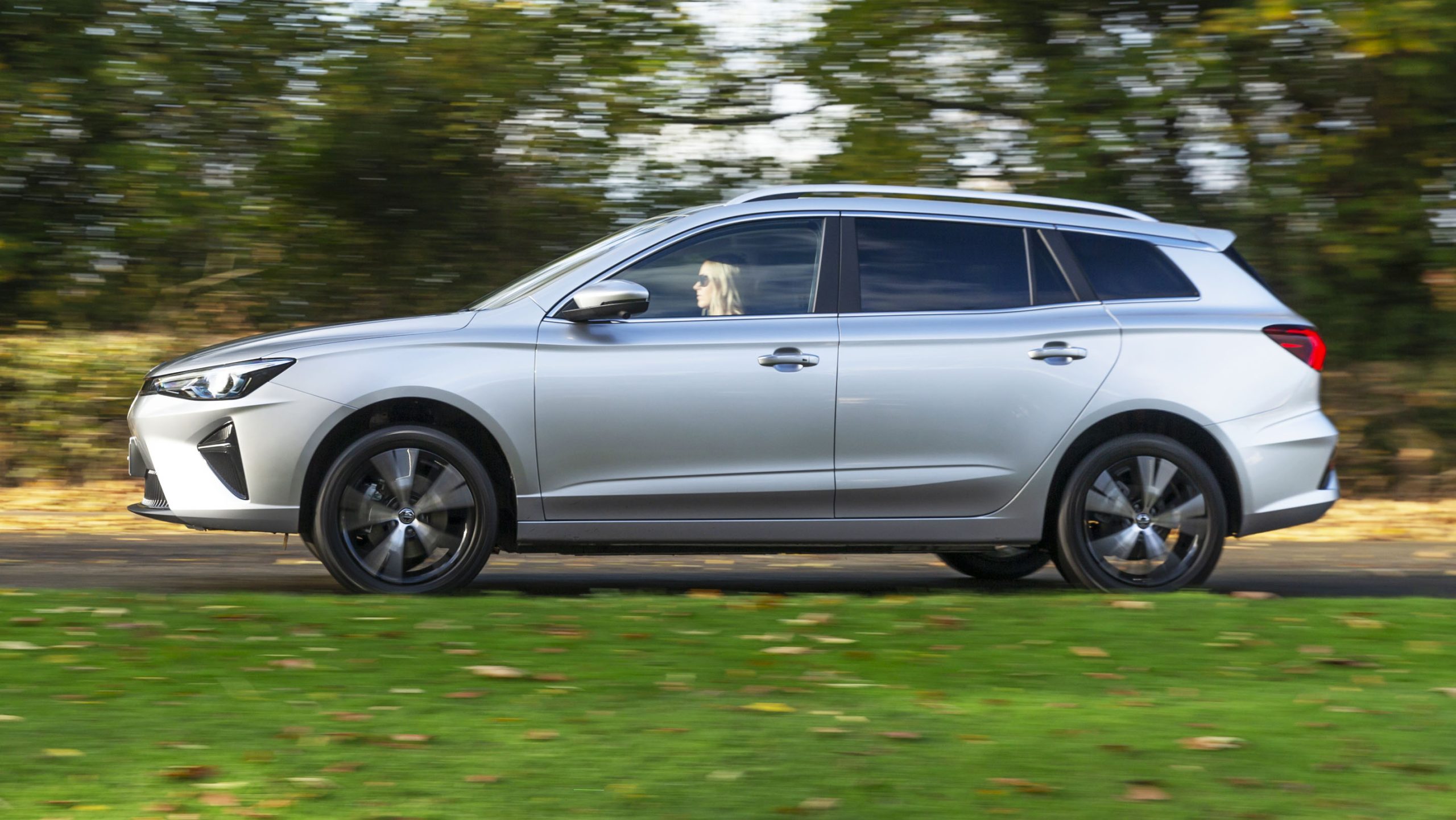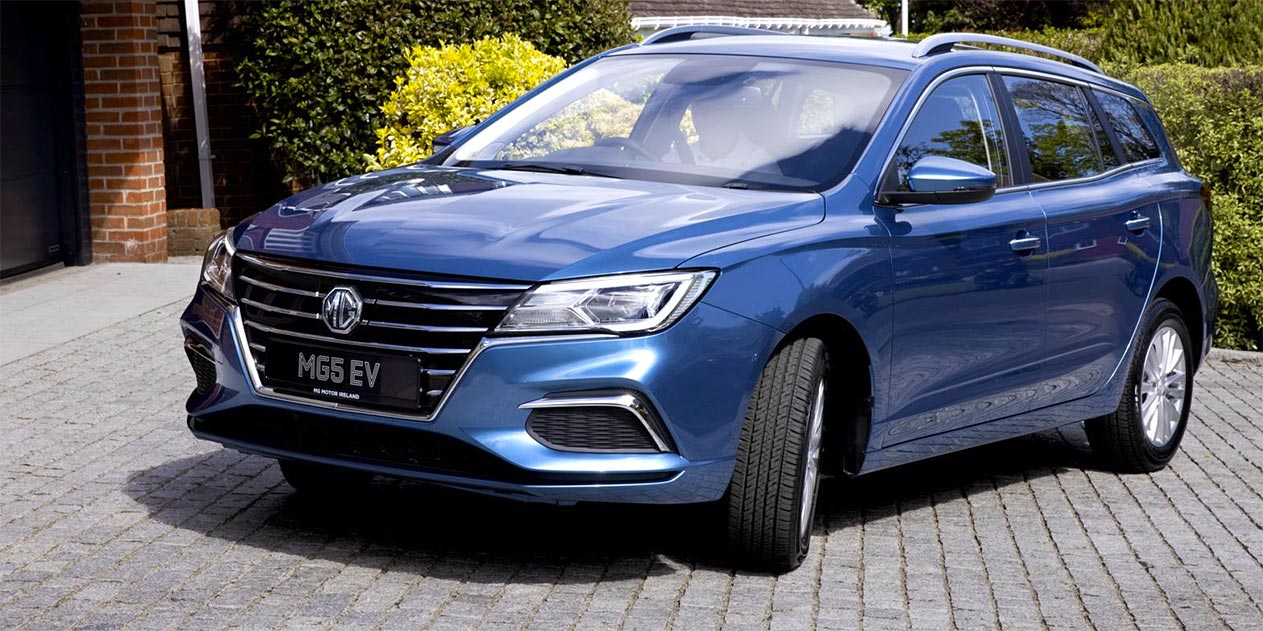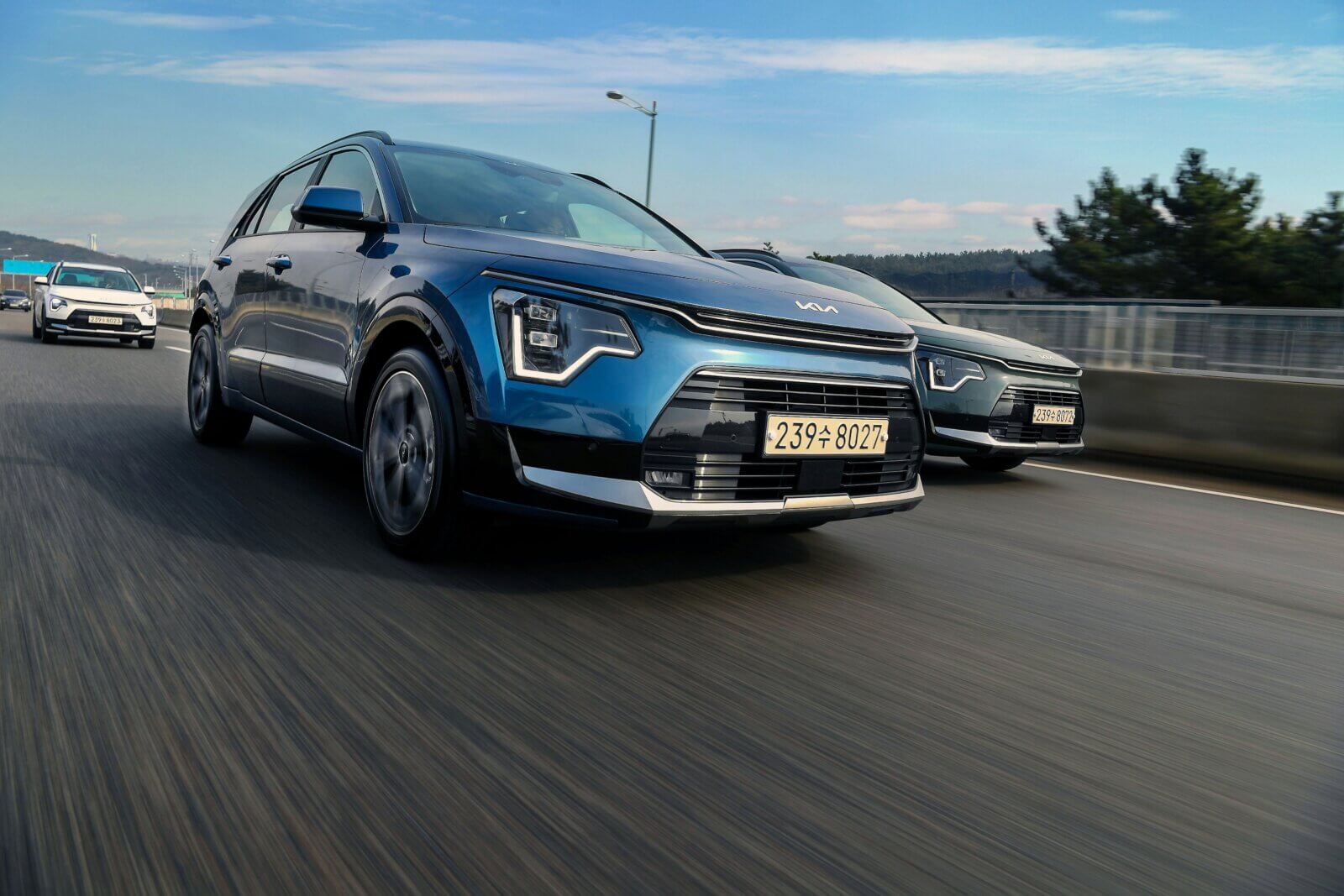
Top electric cars for families: comfort, space and economy
Today, choosing an electric car for a family is no longer just a decision about the environment or fuel economy. It's about comfort, safety, and space for all family members, including kids with car seats and, of course, the things you always need when walking or travelling. Let's find out which electric car models are considered the best for family needs and what you should consider when choosing one.
Content:
Today, choosing an electric car for a family is no longer just a decision about the environment or fuel economy. It's about comfort, safety, and space for all family members, including kids with car seats and, of course, the things you always need when walking or travelling. Let's find out which electric car models are considered the best for family needs and what you should consider to ensure that your purchase meets your expectations.
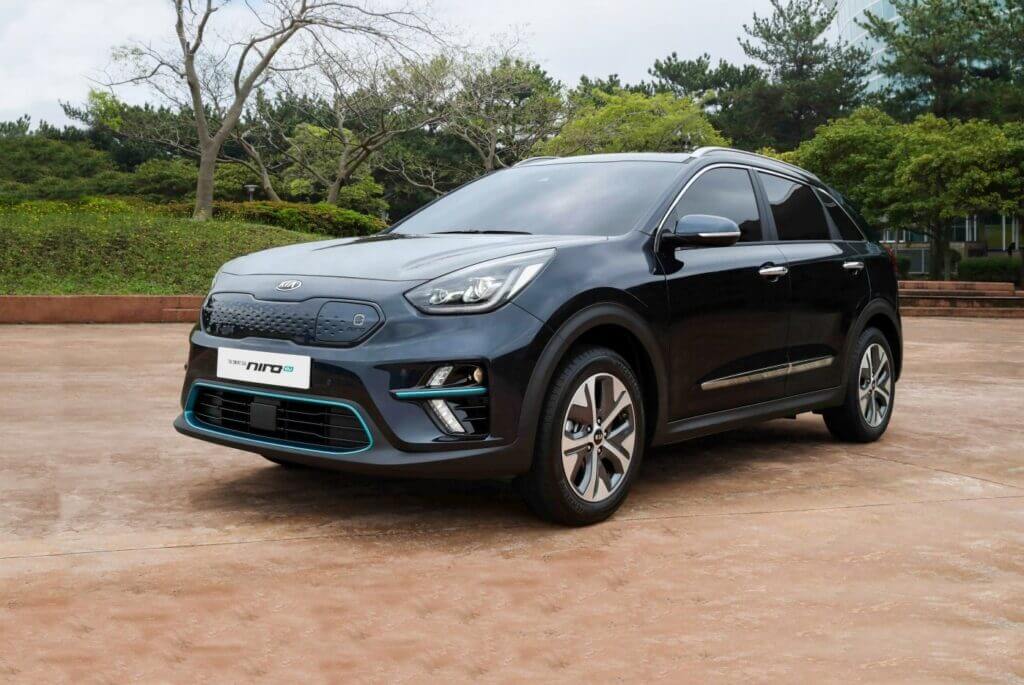
1. Kia Niro EV
The Kia Niro EV is an all-electric crossover designed for the European, US and Korean markets, with technical characteristics similar to the Hyundai Kona EV. The car is equipped with a 150 kW electric motor that delivers 204 horsepower. It offers a comfortable range of 385 km on a single charge thanks to a 64 kWh lithium-polymer battery. A model with a 39.2-kWh battery is also available, which provides a range of up to 246 km on a single charge. The Kia Niro EV can be charged with a 100 kW fast charger, which allows it to achieve 80% of charge in 54 minutes.
This crossover features a range of active safety systems, including automatic collision warning and intelligent cruise control. It also features Lane Follow Assist, which keeps the vehicle in its lane by monitoring markings and traffic ahead. Lane Follow Assist operates at speeds from 0 to 130 km/h, making it convenient in both urban and motorway environments.
The design of the Kia Niro EV has a futuristic look, developed in Kia's creative centres in California and Korea. The car is based on a platform that allows for the placement of powertrains without compromising interior space. With a 2,700 mm wheelbase, 1,805 mm width and 1,560 mm height, the cabin can accommodate five passengers, while a 451-litre boot provides storage space. The design includes distinctive features such as an integrated charging port in the grille, LED daytime running lights and two-tone 17-inch wheels with regenerative braking system.
General characteristics:
- Body type: Crossover
- Type of drive: Electric
- Engine power: 204 hp (150 kW)
- Battery capacity: 64 kWh or 39.2 kWh
- Range (WLTP): 385 km or 246 km (depending on battery capacity)
- Charging time (DC): Up to 80% in 54 minutes
- Acceleration 0-100 km/h: 7.8 seconds
- Safety systems: Collision warning, intelligent cruise control, Lane Follow Assist
- Dimensions: Wheelbase 2700 mm, width 1805 mm, height 1560 mm
- Trunk volume: 451 litres
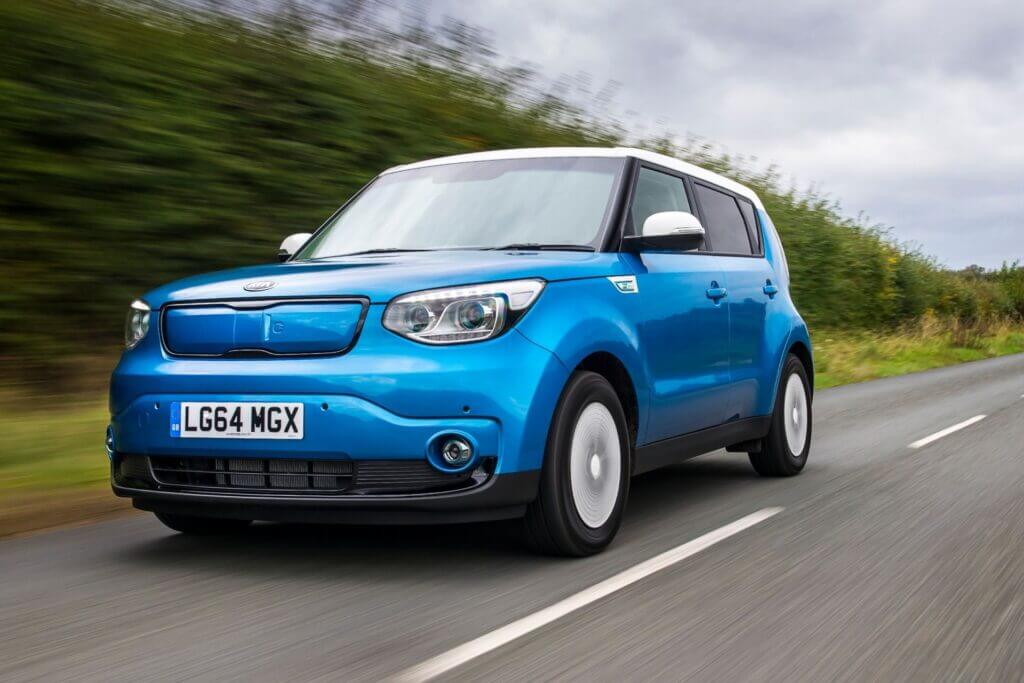
2. Kia Soul EV
The Kia Soul EV is the first production electric vehicle from the South Korean concern Kia aimed at the global market. It is based on the popular Kia Soul hatchback crossover, which allowed the manufacturer to test the perception of eco-friendly cars in different countries. The car's appearance resembles the petrol version, but has a number of distinctive details, such as a closed grille, which indicates its electric nature. This closed area houses the charging connector, as well as other distinctive elements that make the Kia Soul EV recognisable among other electric cars.
The electric vehicle is equipped with a 110 horsepower engine powered by a 27 kWh lithium-ion battery. This provides a driving range of up to 212 km according to the NEDC standard or 150 km according to the EPA cycle. The Kia Soul EV supports standard 6.6 kW charging as well as fast charging, which allows the battery to be charged to 80% in about 30 minutes at special stations. The car has a top speed of 145 km/h and acceleration to 100 km/h takes 11.2 seconds.
The interior of the Kia Soul EV remains spacious and comfortable for daily commuting and long-distance travel. The car can comfortably accommodate five passengers, while maintaining sufficient luggage space. A special feature of the model is the high seating position of the driver and passengers, which makes it comfortable for city driving and provides a good overview. The interior of the electric vehicle includes high-quality fabric materials and a liquid crystal instrument panel that provides the necessary information about the car's operating modes.
General characteristics:
- Body type: Hatchback
- Type of drive: Electric
- Engine power: 110 hp (90 kW)
- Battery capacity: 27 kWh
- Cruising range (NEDC/EPA): 212 km / 150 km
- Top speed: 140 km/h
- Acceleration 0-100 km/h: 11.2 seconds
- Charging time: 6-8 hours (domestic network), 4-5 hours (industrial network), 30 minutes (fast charge)
- On-board charging equipment: 6.6 kW
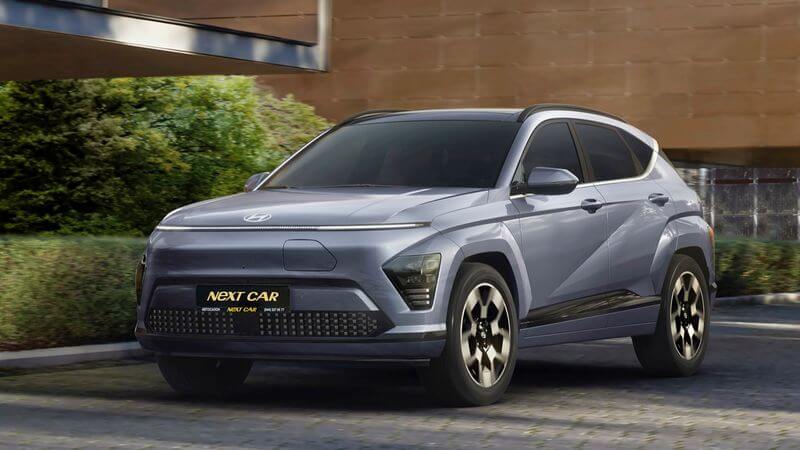
3. Hyundai Kona Electric "Long-range"
Hyundai Kona Electric "Long-range" is a modification of the subcompact crossover equipped with an enlarged 64 kWh battery, which significantly increases the range. According to the WLTP standard, the car can cover up to 449 kilometres on a single charge. Compared to the base version, the model has a more powerful 150 kW electric motor, which produces 204 horsepower. As a result, acceleration to 100 km/h takes only 7.6 seconds, which gives the crossover additional dynamism.
The larger battery takes longer to charge. Connecting to the 7.2 kW on-board charger takes about 9 hours and 40 minutes. However, when using a 100 kW fast charger, the charging time remains the same, allowing the battery to be charged to 80% in 54 minutes. The exterior and interior of the Hyundai Kona Electric "Long-range" do not differ from the base version: the car has the same colour options for the body and roof, and retains the same level of comfort in the cabin.
The model is designed with an emphasis on preserving space in the cabin and trunk, even with the increased battery capacity. This allows for comfortable passenger seating and ample luggage space, making the car convenient for both city and long-distance travel. The improved dynamics of the model are felt from the first press of the accelerator pedal, making Hyundai Kona Electric "Long-range" an attractive option for drivers who value a combination of performance and range.
General characteristics:
- Body type: Crossover
- Type of drive: Electric
- Engine power: 204 hp (150 kW)
- Battery capacity: 64 kWh
- Cruising range (WLTP): 449 km
- Top speed: 140 km/h
- Acceleration 0-100 km/h: 7.6 seconds
- Charging time: 9 hours 40 minutes (from 7.2 kW on-board unit), 54 minutes (up to 80% on 100 kW fast charger)
- Energy consumption: 15.2 kWh/100 km
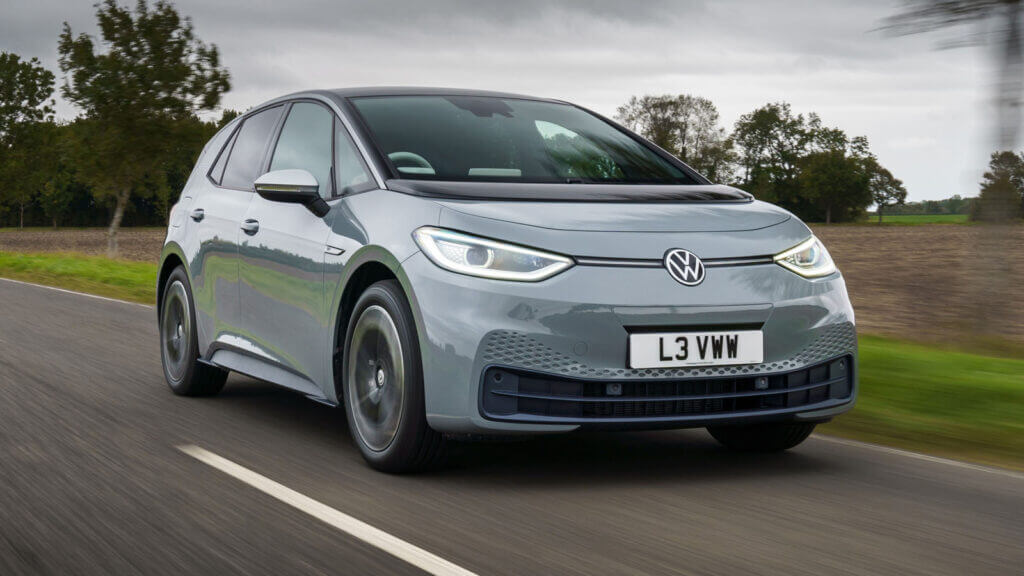
4. Volkswagen ID.3 1ST (Mid-Range)
The Volkswagen ID.3 1ST (Mid-Range) is a mid-range electric hatchback developed on the MEB platform, Volkswagen's first dedicated electric platform. The model features increased interior space thanks to a compact arrangement of the main drive components. The electric motor has a power output of 150 kW, which enables a top speed of 160 km/h. The ID.3 1ST has a range of up to 420 km in the WLTP cycle, making it suitable for daily use in the city and on longer routes.
The ID.3 electric drive combines a permanent magnet synchronous motor located on the rear axle with the gearbox and power electronics to form a compact unit. The 58 kWh battery pack is located at the bottom of the body to help make optimum use of the space in the cabin. The battery can be recharged either from an 11 kW AC source or from a 100 kW fast charger, allowing the vehicle to replenish its 290 km range in 30 minutes.
The exterior design of the Volkswagen ID.3 1ST is characterised by the absence of a radiator grille and recognisable LED matrix headlights, which emphasise the electric nature of the model. The interior of the car is focused on simplicity and functionality: there are no unnecessary controls in the cabin, and the central tunnel remains open. Many of the car's functions are controlled via touch buttons or voice control, giving the ID.3 a modern look with a technological edge.
General characteristics:
- Body type: Hatchback
- Type of drive: Electric
- Engine power: 150 kW
- Battery capacity: 58 kWh
- Cruising range (WLTP): 420 km
- Top speed: 140 km/h
- Charging: 11 kW (AC), 100 kW (DC)
- Charging time (DC): up to 290 km in 30 minutes
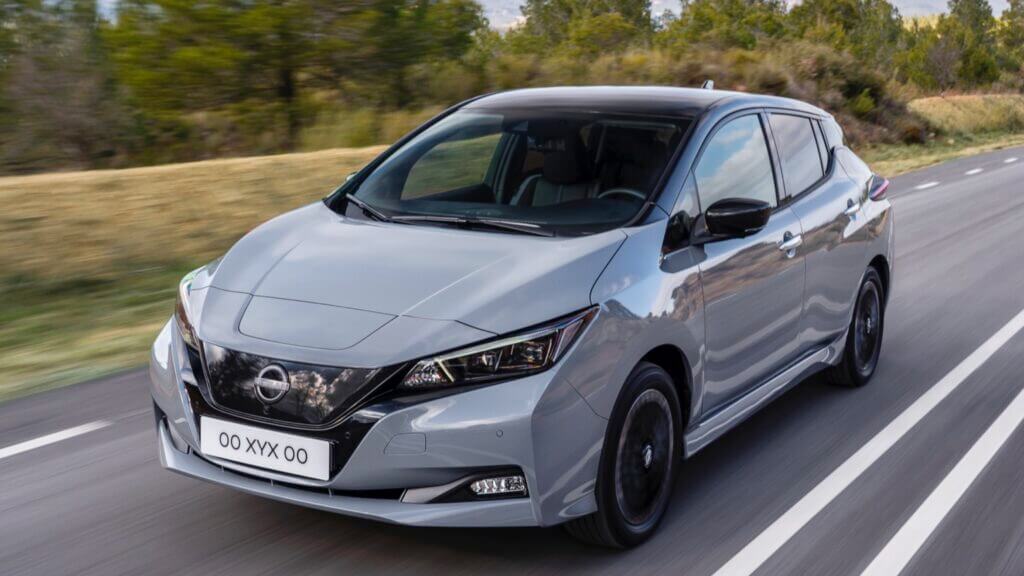
5. Nissan Leaf e+ 2019 (62 kWh)
The 2019 Nissan Leaf e+ is an updated version of the second generation model, which received a more powerful 62 kWh battery and a number of technical changes. The new battery has increased the energy density by 25% compared to the previous model by 40 kWh, which has increased the range to 364 km according to the EPA standard and 385 km on the WLTP cycle. The battery contains 288 cells instead of 192, and although its height has increased by 5 mm, this has not affected the interior space and external dimensions of the car.
The updated 160 kW engine delivers 340 N-m of torque, which has increased acceleration dynamics by 13% compared to the previous version. The car now accelerates faster from 80 km/h to 120 km/h, which contributes to more confident overtaking and improved agility on the road. The top speed has increased by 10%, making the Leaf e+ suitable for higher speed driving.
The Nissan Leaf e+'s charging system includes a 70 kW CHAdeMO fast port (with a peak capacity of up to 100 kW), which allows the battery to be charged up to 80% in the same time as the previous version. The model is also equipped with an updated multimedia system with an 8-inch smartphone-compatible display and a navigation system with internet updates. In addition, innovative energy management technologies are available, including Car-to-Grid (V2G), which allows the Leaf e+ to transfer electricity back to the grid.
General characteristics:
- Body type: Hatchback
- Type of drive: Electric
- Engine power: 160 kW
- Battery capacity: 62 kWh
- Cruising range (EPA/WLTP): 364 km / 385 km
- Charging time (up to 80%): when connected to 100 kW - the same as the 40 kWh version
- Top speed: 10% higher than the previous version
- Features: updated multimedia system, V2G
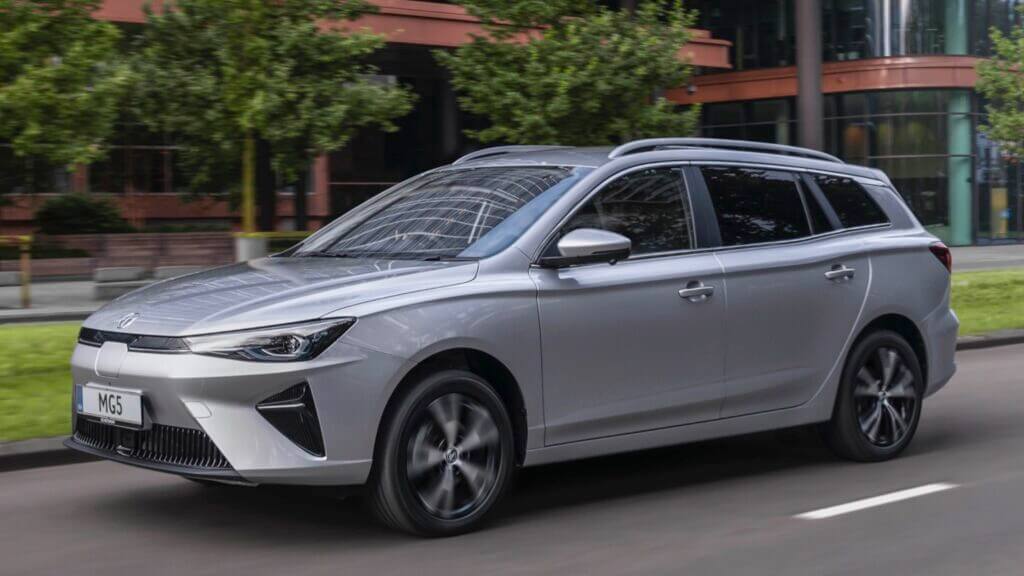
6. MG5 Electric Long Range 61.1kWh FWD 2022
The MG5 Electric Long Range is a C-class electric station wagon from the British brand MG, which is now owned by the Chinese concern SAIC. The model is presented on the European market, where it currently has no direct competitors among electric vehicles of a similar body. The MG5 Electric is based on the Roewe Ei5 model, which was originally available only in China but was adapted for sale in Europe after being restyled. The station wagon is equipped with an updated interior and has a modern exterior design developed specifically for European consumers.
The MG5 Electric is available in two versions with different battery capacities. The Long Range version has a 61.1 kWh battery, which enables a range of up to 400 km on a single charge (WLTP). The 115 kW (156 hp) electric motor is mounted on the front axle and provides acceleration to 100 km/h in 8.3 seconds. The model has a top speed of 185 km/h. The MG5 Electric can be charged via a high-speed charger with a capacity of up to 87 kW, which allows the 80% to be recharged in a short time. The model is also equipped with a household socket for powering small electrical appliances, which increases its functionality.
The MG5 Electric is equipped with MG Pilot electronic assistants, which include adaptive cruise control, lane keeping assist, blind spot monitoring and other safety features. The interior is equipped with a 10.25-inch touchscreen multimedia system, a 7-inch digital instrument cluster, and a convenient six-speaker audio system.
General characteristics:
- Body type: Station wagon
- Type of drive: Front
- Engine power: 115 kW (156 hp)
- Battery capacity: 61.1 kWh
- Cruising range (WLTP): 400 km
- Top speed: 185 km/h
- Acceleration time 0-100 km/h: 8.3 seconds
- Maximum charging power: 87 kW
- Equipment: MG Pilot, LED headlights, 10.25-inch multimedia system screen, reversing camera
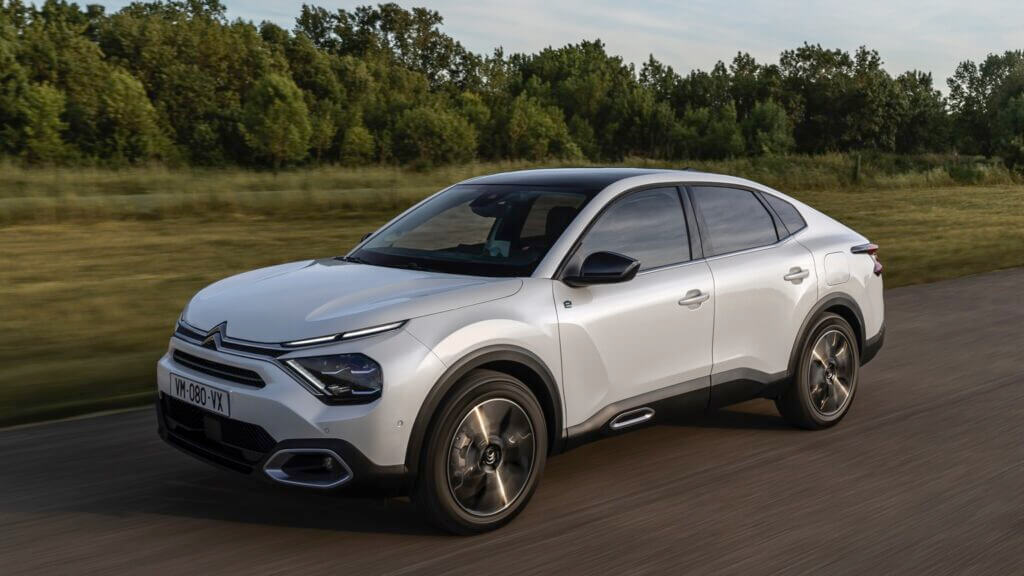
7. Citroën ë-C4
The Citroën ë-C4 is an electric version of the popular hatchback that retains all the main features of the internal combustion engine models, but with a smooth and quiet ride and no CO₂ emissions. This car offers three driving modes: Normal for a balance between power and range, Eco for energy savings, and Sport for more dynamic driving. The range of the model is up to 420 km, which is provided by a 156 hp electric motor. The battery warranty is valid for 8 years or 160,000 km and covers the 70% retaining its original capacity.
There are several ways to charge the Citroën ë-C4. At home, you can use the 7.4 kW or 11 kW Wall Box charging station, which provides a full charge in 7.5 or 5 hours respectively. For shorter charging sessions, there is a Green'Up socket that adds 100 km of range in 4.5 hours. A 100 kW fast charger is also available, which gives you 100 km of range in just 10 minutes.
The Citroën ë-C4's digital instrument cluster features an intuitive interface designed for electric vehicles. A special display shows the current charge level, range, energy flow and heating settings. On the 10-inch touchscreen, the driver can view information about the battery status, the time required for a full charge and much more.
General characteristics:
- Body type: Hatchback
- Type of drive: Electric
- Engine power: 156 hp.
- Cruising range (WLTP): 420 km
- Wall Box charging time (7.4 kW): 7.5 hours
- Charging time for Wall Box (11 kW): 5 hours
- Fast charging time (100 kW): 10 minutes for 100 km
- Interface: 10-inch touch screen, digital panel
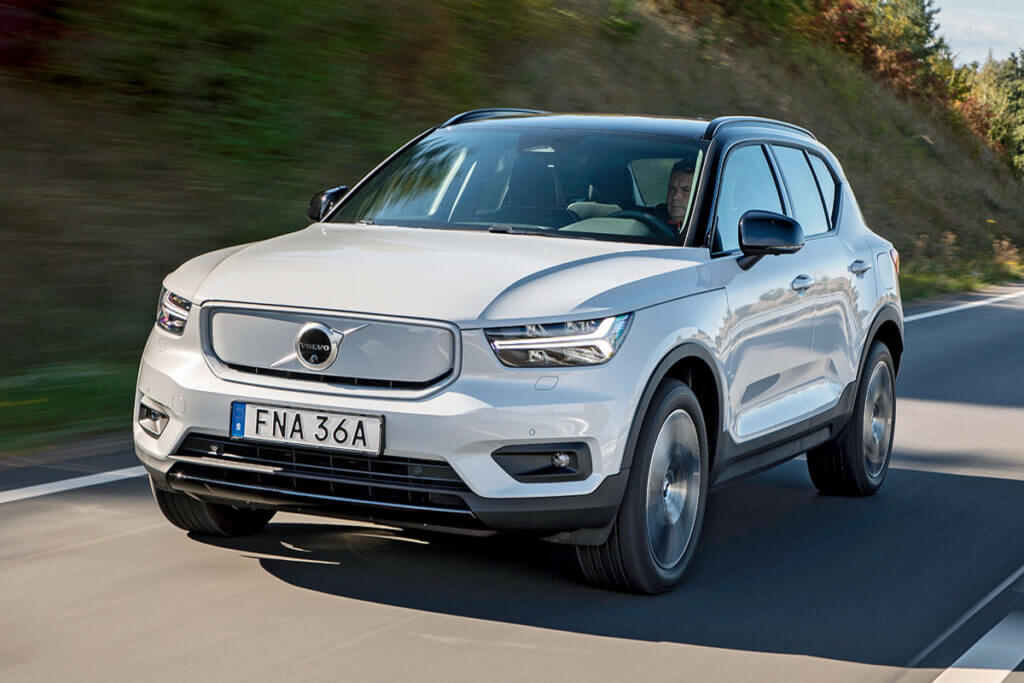
8. Volvo XC40 Recharge P8 AWD
The Volvo XC40 Recharge P8 AWD is Volvo's first all-electric vehicle based on the popular XC40 compact crossover. The model combines the reliability and environmental friendliness of an electric drive in an SUV format. The car is equipped with two electric motors on the front and rear axles, which provides all-wheel drive with a total output of 408 hp. This power allows the XC40 Recharge to accelerate to 100 km/h in 4.9 seconds.
The model has a 78 kWh battery that provides a range of approximately 400 km (WLTP). The Volvo XC40 Recharge can be charged using a standard 11 kW AC charger, which takes approximately 7.5 hours. Alternatively, a 150 kW DC fast charger is available, which can charge the battery from 10 to 80% in 40 minutes.
The Volvo XC40 Recharge retains the characteristic features of the base XC40 model, including a closed grille, a new Sage Green body colour and an additional luggage compartment under the bonnet. The interior of the model is unique thanks to the presence of an Android-based infotainment system that includes Google Assistant, Google Maps and supports airtime updates.
General characteristics:
- Body type: Crossover
- Type of drive: Full
- Engine power: 408 hp (304 kW)
- Battery capacity: 78 kWh
- Cruising range (WLTP): 400 km
- Charging time (11 kW): 7.5 hours
- Fast charging time (150 kW): 40 minutes for 80%
- Top speed: 140 km/h
- Information system: Android-based
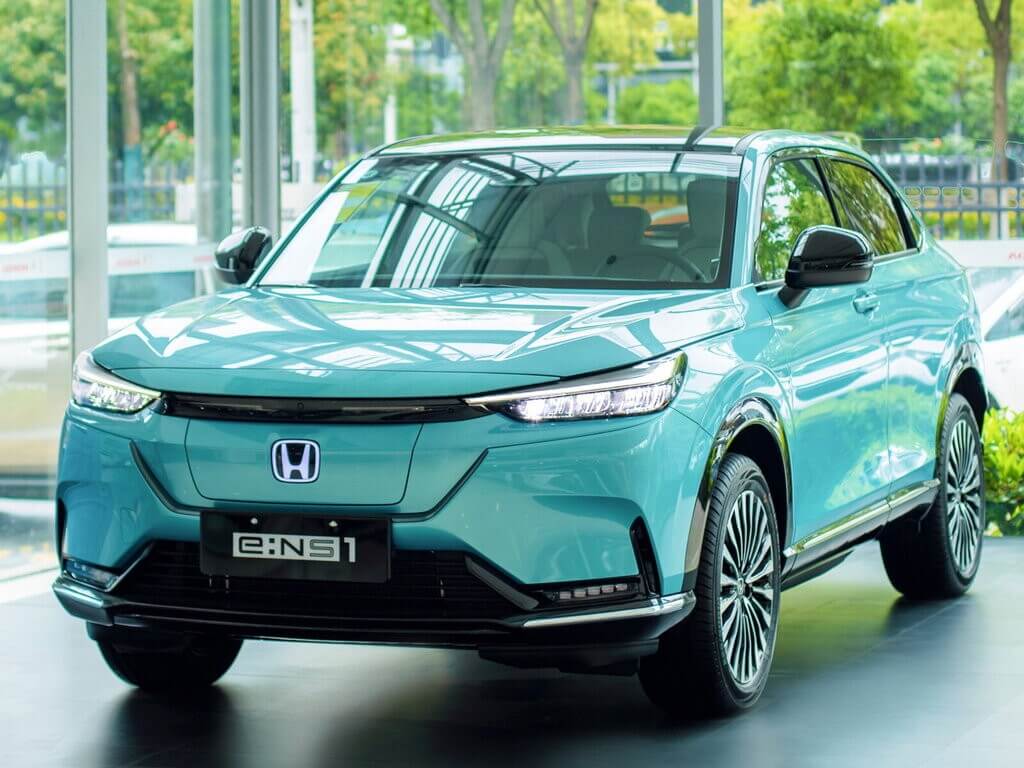
9. HONDA e:NS1 TOP
The HONDA e:NS1 TOP is an electric crossover that combines future technologies with stylish looks. It has been produced since 2022 at the factories of the Chinese automaker Dongfeng and is built on the e:N Architecture platform, specially designed for front-wheel drive electric vehicles. The platform provides manoeuvrability and dynamic stability, making the crossover suitable for both city driving and travelling.
This model is available in four trim levels, which differ in engine power and battery capacity. The E-type is equipped with a 134 kW electric motor and a 53.6 kWh battery with a range of up to 420 km. The E-dynamic version has a 150 kW motor and 68.8 kWh battery, which allows it to travel up to 510 km on a single charge. These features make the HONDA e:NS1 TOP an attractive choice for those looking for a technologically advanced vehicle with a long range.
The exterior has been designed with an emphasis on aerodynamics, which contributes to a smooth and easy-to-handle ride. The exterior incorporates modern elements such as a special front fascia with an illuminated logo, as well as sporty details adapted for efficient driving. The interior features perforated eco-leather and glossy inserts that add space and comfort, especially in the rear row. The HONDA Connect 3.0 infotainment system with a 15.1-inch screen provides convenient control of car functions and constant communication with the "smart home".
General characteristics:
- Battery capacity: 68.8 kWh
- Range: 510 km (CLTC)
- Power: 203 hp.
- Torque: 310 N-m
- Acceleration 0-50 km/h: 3,7 с
- Average energy consumption: 13.8 kWh/100 km
- Top speed: 140 km/h
- Fast charging time (30-80%): 40 min
- Dimensions (L×W×H): 4390 × 1790 × 1560 mm
- Ground clearance: 190 mm
- Type of drive: Front
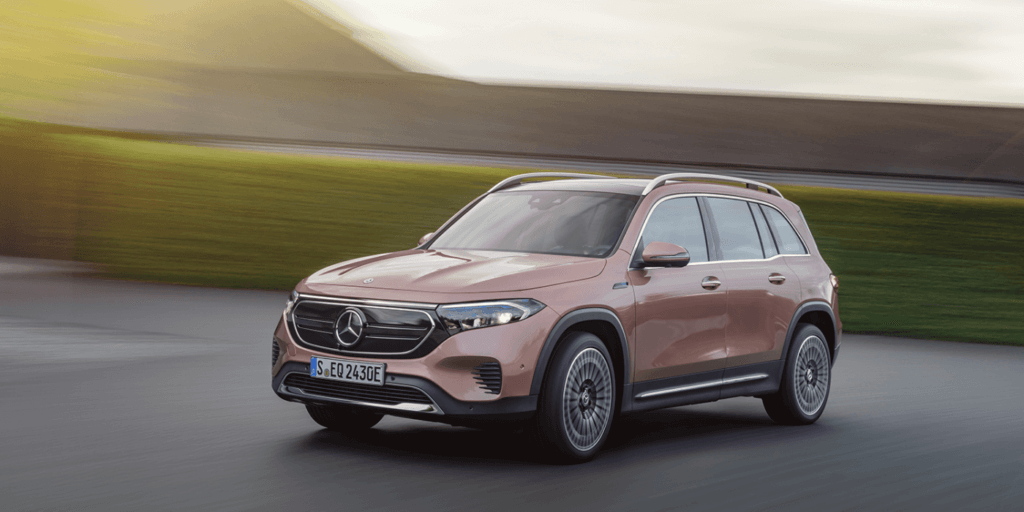
10. Mercedes-Benz EQB
The EQB is an electric crossover from Mercedes-Benz that combines high performance with compact dimensions and is designed to drive confidently in the city and on the highway. Thanks to two powerful electric motors - an asynchronous motor on the front axle and a synchronous permanent magnet motor on the rear axle - the EQB delivers stable all-wheel drive and dynamic acceleration from the first second. The car has a top speed of 160 km/h and 520 Nm of instantaneous torque for smooth start-up and excellent handling.
The intelligent temperature management system optimises battery performance, maintaining a consistent range even in variable conditions. The battery provides a long range, making the car suitable for both daily city driving and long journeys. The EQB's compact, optimal dimensions make it easy to manoeuvre in urban environments, while its spacious interior and large boot make it a convenient choice for family trips.
General characteristics:
- Electric motor: Two motors - asynchronous on the front axle and synchronous on the rear axle.
- Power: Up to 215 kW, with a torque of up to 520 Nm.
- Top speed: 140 km/h
- Battery: Long range with intelligent temperature management.
- Drivetrain: All-wheel drive, with a single-speed transmission.
- Dimensions: Optimal for urban and country roads.
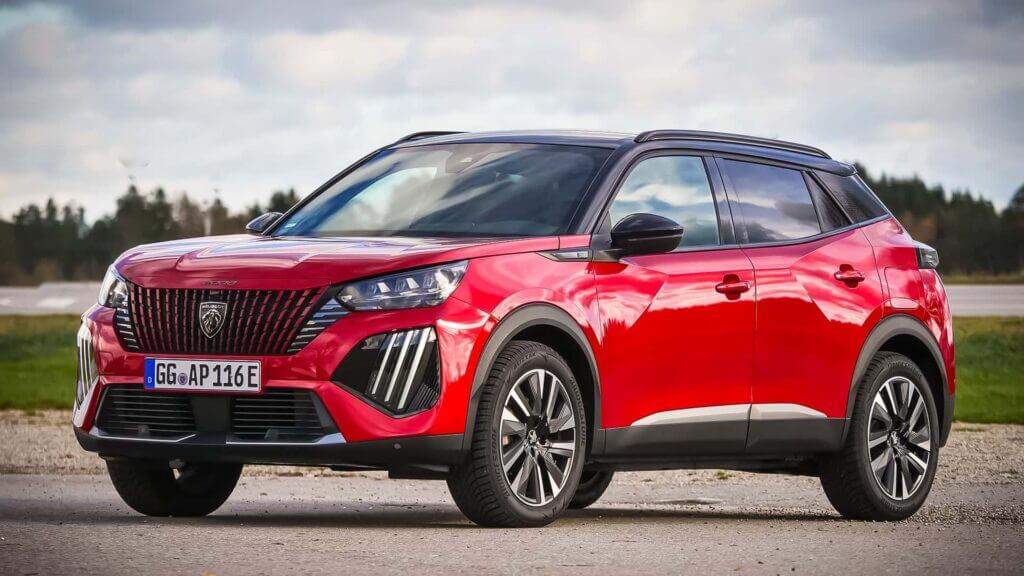
11. Peugeot e-2008
The Peugeot e-2008 is an electric version of the compact crossover designed for daily use in the city and equipped with technologies that meet modern emission requirements. The electric vehicle is based on the e-CMP platform, which was developed by PSA to be adapted to different electric models. The platform allows the integration of a 100 kW (136 hp) electric motor with torque transmitted to the front wheels.
The Peugeot e-2008 is equipped with a 50 kWh battery that provides a range of up to 310 km on the WLTP cycle. Charging options include both conventional home sockets and fast chargers, which can recharge up to 80% of battery in just 30 minutes. The compact battery is located in the lower part of the body, leaving plenty of space for the 434-litre luggage compartment, which is ideal for urban use.
The design of the Peugeot e-2008 retains similarities to the internal combustion engine versions, but features distinctive elements such as a body-coloured front grille and no tailpipes. The interior of the car is well configured and high-tech, with the iCockpit system adding to the convenience with a 3D display and 10-inch screen.
General characteristics:
- Electric engine: 100 kW (136 hp)
- Battery: 50 kWh, range 310 km (WLTP)
- Charging: 7.4 kW/11 kW; 100 kW fast charge (up to 80% in 30 minutes)
- Drivetrain: Front wheel drive
- Top speed: 140 km/h
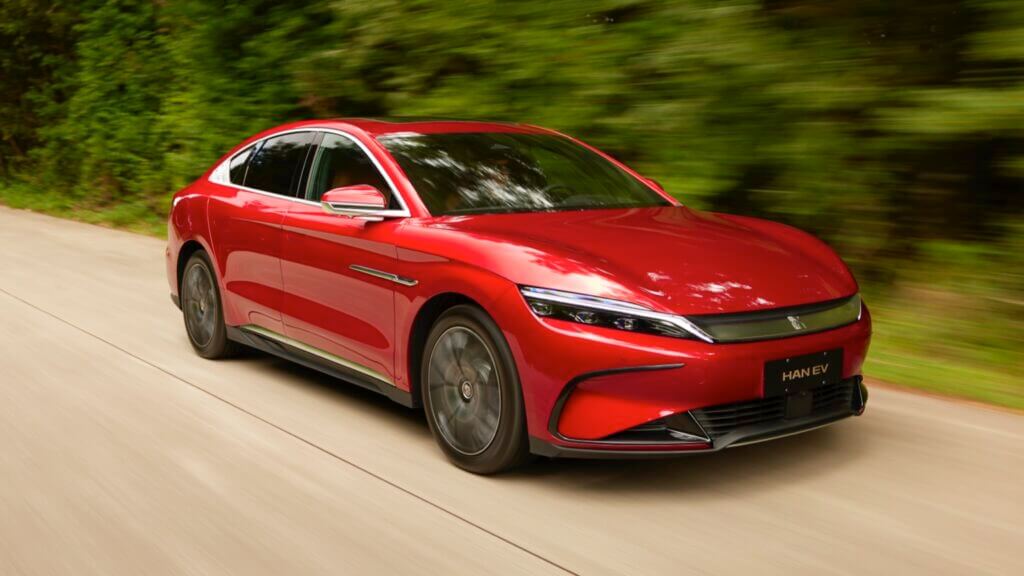
12. BYD Han EV
The BYD Han EV is a business-class electric vehicle from China that combines modern design, a powerful electric motor and innovative technologies to improve comfort and safety. The car is equipped with a lithium-iron-phosphate battery with a capacity of 60.48 to 85.44 kWh, which provides a range of 491 to 715 km depending on the configuration. The front-wheel drive models reach 100 km/h in 7.9 seconds, while the all-wheel drive version is able to reach this speed in just 3.9 seconds, which underlines its high dynamics.
The exterior of the BYD Han has bold shapes: slender headlights, a sporty bonnet and a sleek bumper create an elegant look. The interior of the model is decorated with premium materials and has a large 15.6-inch swivel touchscreen that integrates the main car control functions. The dashboard is equipped with a 12.3-inch screen that complements the digital driver interface. The car features ergonomic front seats with electric adjustment, heating and ventilation, as well as spacious rear seats with additional customisation options.
The BYD Han EV is also equipped with advanced active and passive safety systems. The safety features include adaptive cruise control, tyre pressure monitoring, all-round cameras for panoramic views, as well as sensors for blind spot monitoring and collision warning systems. The intelligent DiLink system enables wireless Wi-Fi access, smartphone integration and remote control of individual vehicle settings.
General characteristics:
- NEDC range: 491 to 715 km
- Battery: 60.48 to 85.44 kWh
- Engine power: 150 to 380 kW (204-517 hp)
- Torque: 310 to 700 N-m
- Acceleration to 100 km/h: 3,9-7,9 с
- Dimensions (LxWxH): 4995 x 1910 x 1495 mm
- Drive: front or all-wheel drive
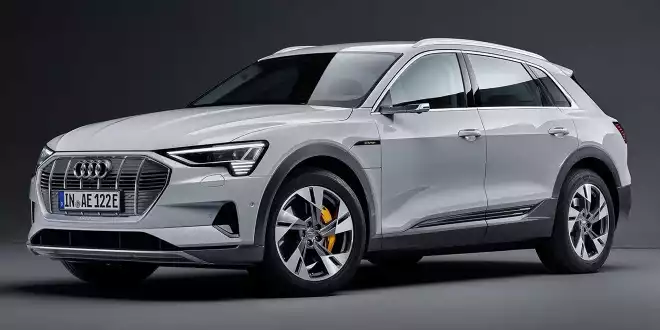
13. Audi e-tron 50 quattro
The Audi e-tron 50 quattro is an electric crossover with all-wheel drive, designed as the entry-level model in the e-tron quattro series. The electric vehicle is equipped with two electric motors, one on the front and one on the rear axle, with a combined output of 230 kW and a maximum torque of 540 N-m. In normal operation, only the rear motor operates, and the front motor is connected only when necessary, providing additional control and stability on the road. The model has a top speed of 190 km/h, which is slightly lower than the more powerful versions of the series.
The battery of the Audi e-tron 50 quattro has a capacity of 71 kWh, which provides a range of up to 299 km in the WLTP cycle. The battery weight has been reduced by 120 kg compared to other e-tron models, making this version of the crossover more energy-efficient. The electric car supports fast charging with a capacity of up to 120 kW, which allows partial charging in 30 minutes, and the car can be charged with 11 kW from a three-phase AC source.
The interior of the Audi e-tron 50 quattro retains the high-tech control panel with multiple touchscreens that control the multimedia functions, navigation and climate control. The interior of the crossover meets the needs of comfort, offering comfortable seats and modern ergonomics. The safety systems include both active and passive safety features, making the vehicle suitable for everyday use and travel.
General characteristics:
- Body type: crossover
- Model: e-tron Quattro
- Motor type: electric
- Electric motor power: 308 hp / 230 kW
- Battery capacity: 71 kWh
- Cruising range (WLTP): 299 km
- Top speed: 140 km/h
- Charging time: 7 h (from 220 V) / 30 min (fast DC charging)
- Type of charging connector: Type 2
- Acceleration 0-100 km/h: 7 с
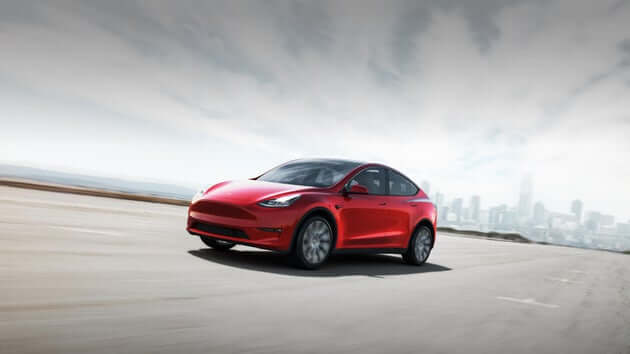
14. Tesla Model Y Standard Range
The Tesla Model Y Standard Range is an electric vehicle with a single 220 kW motor that drives the rear axle. The car has an output of 299 hp and is capable of accelerating to 100 km/h in 6.9 seconds. With an average energy consumption of 13.5 kWh per 100 km and a battery capacity of 60 kWh, the electric car provides a range of around 419 km in a mixed cycle in warm weather. This range can be reduced to 335 km in cold conditions. The model has a top speed of 217 km/h, which makes it convenient for travelling both in the city and beyond.
The battery in the Tesla Model Y supports charging at different levels. When using fast DC charging, the car can achieve a charging capacity of up to 170 kW, which significantly reduces recharging time. The battery has a 400-volt architecture, consists of lithium-iron-phosphate cells, and does not support the return of energy to the grid (V2G). The charging time from a household outlet or three-phase (AC) source is up to 11 kW.
The Model Y provides comfort for the driver and passengers with a ground clearance of 168 mm and a large luggage compartment with a volume of 854 litres, as well as an additional front luggage compartment of 117 litres. The vehicle's interior includes comfortable seating for five people and a high level of safety, confirmed by a 5/5 Euro NCAP rating.
General characteristics:
- Body type: crossover
- Battery type: lithium iron phosphate (LFP)
- Battery capacity: 60 kWh
- Cruising range (WLTP): 455 km
- Acceleration 0-100 km/h: 6,9 с
- Top speed: 140 km/h
- Drive: rear wheel drive
- Charging power (AC/DC): 11 kW / 170 kW
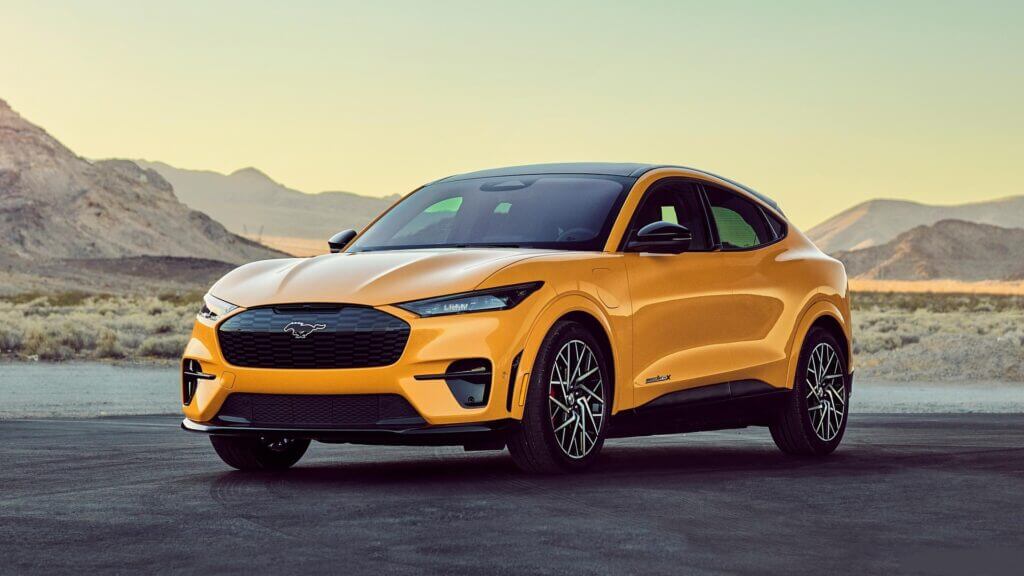
15. Ford Mustang Mach-E 2020
The Ford Mustang Mach-E is a K2 electric crossover with rear- or all-wheel drive options, which has become a new direction for the Ford brand. The model made its debut on 17 November 2019 in Los Angeles. Equipped with the GE2 platform, this model includes a McPherson front suspension and a multi-link rear suspension, providing stability and comfort on the road. The size of the Mach-E is similar to the Mercedes GLC and Porsche Macan, although the Tesla Model Y is considered a key competitor.
The exterior of the Mach-E has distinctive details that hint at the style of the legendary Mustang: a streamlined silhouette and a special design of the rear lights. An unusual feature of the Mach-E is the absence of traditional door handles - instead, buttons located on the body pillars are used. In the cabin, the driver is greeted by a 15.5-inch vertical screen of the Sync4 multimedia system, which supports wireless connection to Apple CarPlay and Android Auto. Additionally, a 10.2-inch digital instrument cluster display provides all the necessary driving information.
Ford Mustang Mach-E is available in several configurations that differ in engine power and range. The base version has a single 258 hp electric motor and a 75.7 kWh traction battery, which allows it to travel up to 450 km on a single charge. In the version with a larger 98.8 kWh battery, the output increases to 285 hp, providing a range of up to 600 km. There is also an all-wheel drive version that has a power output of 338 hp and a range of up to 540 km. The most powerful GT version is equipped with two motors with a combined output of 465 hp and a 98.8 kWh battery, which gives a range of up to 500 km and acceleration to 100 km/h in three seconds.
General characteristics:
- Body type: crossover
- Platform: GE2
- Engine: electric, 258-465 hp.
- Power reserve: 420-600 km (depending on equipment)
- Battery capacity: 75.7-98.8 kWh
- Drive: rear or all-wheel drive
- Top speed: 190-217 km/h

ECOFACTOR - charging stations and software for electric vehicles
At ECOFACTOR, we aim to contribute to a greener future and the growth of electric transport in Ukraine by providing convenient and reliable solutions for charging electric vehicles. Our activities include building and maintaining charging stations, developing software for managing charging networks, and offering applications that make charging more accessible to EV drivers.
Areas of activity of ECOFACTOR
- Charging stations and accessories: We develop and manufacture various types of chargers, including mobile chargers, stationary AC and DC stations with a capacity of up to 420 kW. All products are manufactured in Ukraine in compliance with European quality standards, which ensures reliability and safety in all weather conditions.
- Service and support: Our team provides warranty and post-warranty service for charging stations, taking into account all customer needs. Our service customers are offered consultations, technical support and the opportunity to purchase chargers and accessories in our online store.
- Software solutions for business (SaaS): ECOFACTOR offers a SaaS platform for managing charging stations. Our solution allows companies to monitor stations, manage the network and monetise charging processes. Our system also includes an app that facilitates the charging process for drivers by providing easy and secure access to charging points.
Our achievements
- Charging network: We have created a network of over 2,100 charging stations that covers Ukraine and goes international, providing charging in more than 12 countries.
- Developed software: Our charging app is popular with EV drivers and has over 65,000 users.
- Energy consumption: We have already completed more than 2,400,000 successful charging sessions, which demonstrates the convenience and popularity of our network among users.
Electric mobility is a step towards a sustainable future. ECOFACTOR is committed to developing the electric vehicle ecosystem by creating infrastructure that facilitates the transition to sustainable transport. We believe that by expanding charging networks, developing new technologies and supporting our users, we are contributing to environmental protection and helping to reduce greenhouse gas emissions.
Conclusion.
So, choosing an electric car for a family is not only a matter of ecology, but also of comfort, safety and convenience for daily travel. Modern models offer a variety of features: spacious interiors, a long range and modern technologies that make every trip a pleasure. Whether you're looking for a roomy crossover for long journeys or a compact option for city roads, an electric car can be a great solution for a family car.



